|


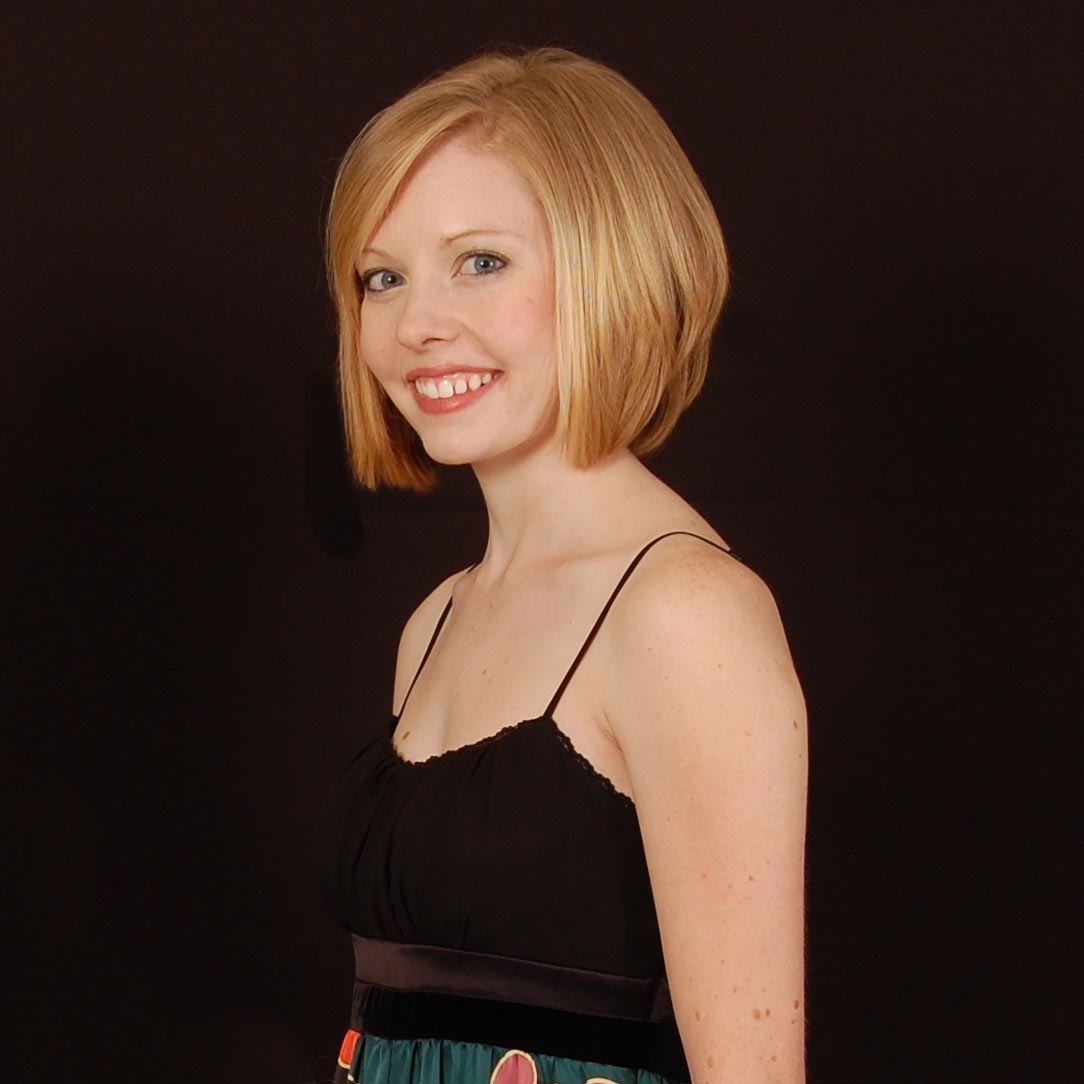
by
Erika Neumayer
American
Aid Society of German Descendants

As an active member of the Jugendgruppe,
when I heard that we would need new Trachten
for competition, I became concerned. I began wondering who would be able to
invest the time to make new skirts, aprons, vests etc. I have participated in
two competitions and each year we have had points deducted because, “our Trachten
look too much like Dirndls”. I wanted the judges to be interested in
our performance, not how much our underskirts are starched. I knew I could help,
but I didn’t know anything about making a Tracht. I was talking to my
school advisor, Dr. Susan Strawn, about this issue and she suggested that since
I already had an interest in the traditional Donauschwaben
Trachten, I should put together an independent study project. An independent
study meant I would have one semester to complete the tasks that I made for
myself and I would receive university credit. I would make up a schedule for
myself and stick to it. I was nervous, but Dr. Strawn assured me that she would
help guide me, keep me on track, and make this endeavor worthwhile.
 |
Wearing
the Batsch-Sentiwan Tracht with Mrs. Stein |
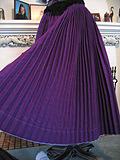 |
I decided that in order to learn how to make a Tracht I
would need to talk to those who have made them. Mrs. Stein immediately came to
mind since I knew she had designed and been the driving force behind the Jugendgruppe
Trachten. I also thought about Mrs. Diestl. My boyfriend, Mike
Schneider, and his mom always talked about the Trachten she made and the Donauschwaben
Trachtenball, so I thought she
would want to help me. And finally, I knew my grandmother Katherina Wagner, had
a small collection of Trachten in her basement that I knew nothing about
and she had made Trachten for my mother when she was in the Jugendgruppe
at the Donauschwaben. I couldn’t decide whom to work with, so I decided
to work with all of them. I would work for five weeks on one Tracht,
making the entire garment. I would also talk to each of the women and learn
about how these garments changed their lives and what the culture was behind
these unique dresses.
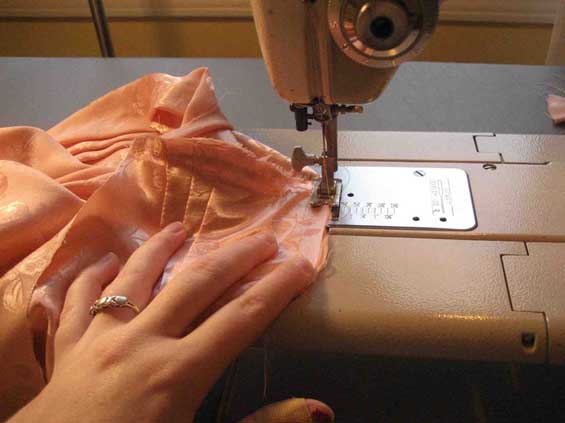 |
Working
on the blouse for the "Neu-Slankamen Tracht" |
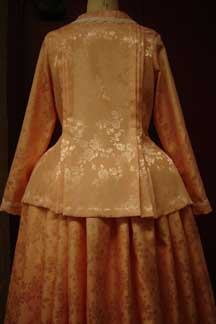 |
After
proposing my idea to the fashion department in May 2007, they gladly accepted my
project and I could begin my research, and our trip to Europe was just the
place. At the Donauschwaben Zentralmuseum
in Ulm, I tended to drift from the group and stare blankly into the closets
filled with blouses, underskirts, vests etc. Thanks to Renee Stein and her super
digital camera I was able to photograph most of the Trachten. There was
so much to look at, but I still didn’t know how they were made.
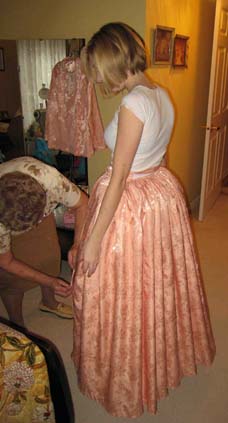 |
Putting
on all the layers of the "Neu-Slankamen Tracht"

I
am wearing the "Neu-Slankamen Tracht" with Mrs. Diestl

|
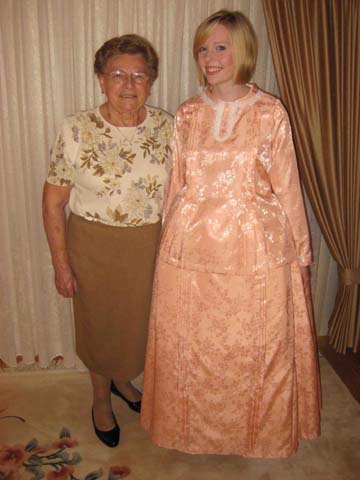 |
In Sindelfingen, we visited the Donauschwaben headquarters. There they
had an extensive library with everything Swabian. I was sure that there
would be some kind of book that had all the different Trachten from the
Donauschwaben region, but when I asked… the woman simply said, “No we
don’t have a book like that, but you can come back here and write one!” I
was not ready to start anything like that! Anyway, they also had a beautiful
collection of Trachten, which Renee photographed for me, so I had some
type of visual to show Dr. Strawn upon my return.
When
we got back to the US, I tried to organize the pictures, but it had been three
weeks since I had been to Ulm or Sindelfingen and I had lost track of where many
of the Trachten came from. So I called up Mrs. Stein, Mrs. Diestl and my
grandma to set a date to talk with each of them about the project and make a
plan. And sticking to the plan, when the fall 2007 semester rolled around I was
ready to start working on my first Tracht with Mrs. Stein.
The
Batsch-Sentiwan Tracht was one
that Mrs. Stein herself never wore, but she remembered her mother wearing one.
We looked at the Batsch-Sentiwan Tracht from the Museum in Lake Villa for
reference and other pictures she had at home. I met with her once a week and she
gave me regular assignments and carefully critiqued my work. She was a great
mentor.
This
Tracht included, a cotton blouse, fully pleated top skirt, scarf and
apron. I tried my best and for my first attempt I felt very proud of my work. I
tried to make a scarf with a floral inset by using two fabrics and I made
replica thread buttons from key rings and thread for the blouse. Pleating the
skirt was the hardest part, especially considering I underestimated the amount
of fabric I would need. The finished skirt used nearly 6 yards of fabric! After
working from September 7th to October 5th ,2007, I had
finally completed the first Tracht and was ready to start the next with
Mrs. Diestl.
When
I arrived at Mrs. Diestl’s condo, she was all ready for me. She took out all
of the Trachten that she had made in the past and showed me the Neu-Slankamen
Bilderbuch. We talked about the fabrics and the petticoats and all that went
into making this Tracht, so for our next meeting we were ready to start.
I had a very difficult time finding the right fabric, but when I did the only
colors available were peach and bright yellow…I opted for the peach. Together
we made the blouse, top skirt and underskirts and we were ready to starch them.
Having never starched anything in my life this was a new experience.
 |
Starching
the underskirts with my grandparents in their basement

I
am wearing the "Hodschag Tracht"
with my Grandparents,
Katherina
and Jacob Wagner

|
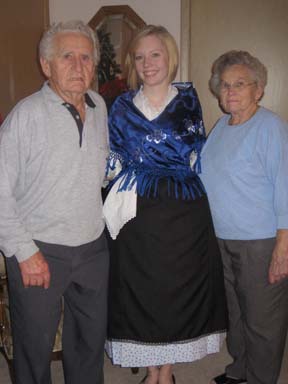 |
Once
the skirts were starched I brought one to school to show Dr. Strawn. While the
skirt was sitting at my sewing station, one of my classmates come over and
looked at it with a puzzled face. She proceeded to touch it and asked me if I
made this skirt out of paper! I explained to her that it was starched and she
was very impressed with my work. The Neu-Slankamen Tracht, had a blouse
and top skirt, but this proved to me much much harder than I ever imagined. This
garment took more time and work than any project I have ever done for school.
After working with Mrs. Diestl from October 5th to November 9th,2007,
I felt proud to have completed my second Tracht that was so different
from the Batsch-Sentiwan Tracht.
I met with my grandma and as we were talking she explained to me that in her
town, Weisskirchen, they didn’t
wear Trachten anymore when she was growing up. She said that only the
older women wore a Tracht and it was usually dark colors and no one
younger than them wore them. I was stuck…. Now what? Then my grandfather
chimed in and started talking about how wonderful the Trachten from his
town, Hodschag, were. After talking
with Dr. Strawn, I started making a Hodschag Tracht. A friend of my
grandfather’s came to visit a few years ago and left 4 full Trachten
and many men’s clothing with my grandma, all from Hodschag. I
photographed all of them and then we spent a few hours inspecting them and
learning how to make them.
The final piece included, a blouse, vest, handkerchief, scarf with hand tied
trim, top skirt, apron, four underskirts. With the completion of this Tracht,
I was finally finished. I wrote up a paper about my experience, all the
wonderful stories I heard and presented it to Dr. Strawn.
After hearing about my project and seeing the photo documentation notebook that
I created, the head of the fashion department wanted the Trachten to be
in the annual Dominican University Fashion Show in April. I am also
participating and showing my Trachten project at Dominican University’s
First Annual Exposition of Undergraduate Research and Creative Investigations as
well as possibly entering in an apparel research competition in the fall. My
sister, Monika Neumayer and I proudly wore two out of the three Trachten
and presented them at the annual Donauschwaben Trachtenball on January
26th, 2008 with our partners Mike Schneider and Mark Bappert. I received first
place recognition for my Tracht and I was honored to have my work
appreciated by the Donauschwaben community.
I am so happy that I completed this project. My admiration for the Donauschwaben
Trachten has increased as well and my appreciation for those who wore and
created them. With the knowledge I gained from working with my three mentors I
am confident that with this new experience, I can help create new competition Trachten
for the Jugendgruppe and keep the Trachten tradition alive.
I would like to continue my research in this area and I hope to one day put
together a Donauschwaben Trachten Bilderbuch of my own, just as the women
from Sindelfingen suggested. I am currently looking to scan images into my
computer to start this project. If anyone would be willing to let me
borrow any books they have about their hometown, I would greatly appreciate it
and you would be recognized for your help. Thanks for reading about my
project and I hope to continue my work and carry on the tradition of those who
came before me.
Erika
Neumayer

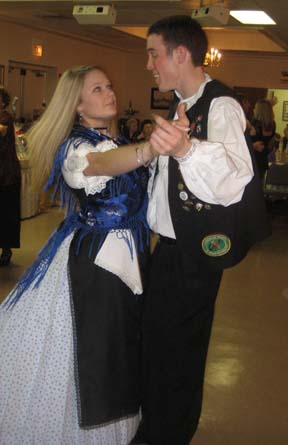 |
My
sister, Monika, wearing the Hodschag Tracht.
Mark
Bappert is wearing an original Hodschag shirt from 1910.
Donauschwaben
Trachtenball
|
|
Erika
and Monika Neumayer
Donauschwaben
Trachtenball
|

|
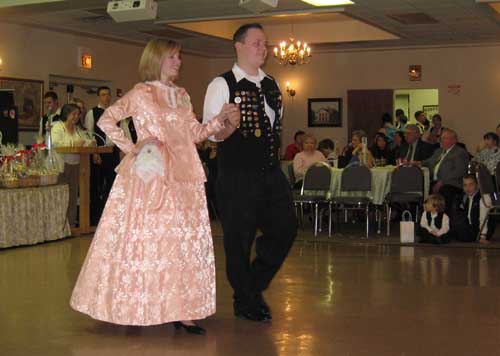 |
Erika
Neumayer and Mike Schneider
Presenting
the first place Tracht entry
at the Donauschwaben Trachtenball
|
| Erika
Neumayer wearing Hodschag Tracht |
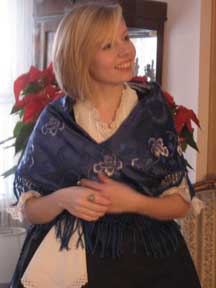 |
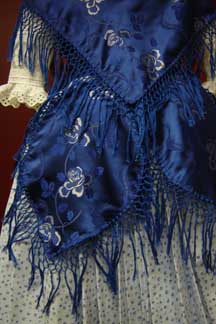 |
Closer
view of Tracht |

For
more information visit Erika Neumayer on her website at:
www.erikaneumayer.com

|